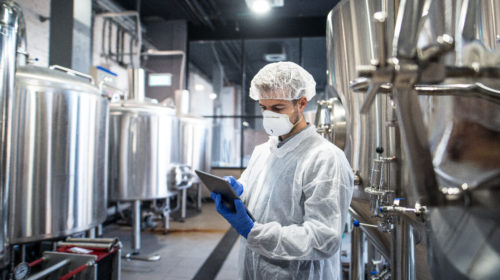
Why world-class OEE shouldn’t be a goal in itself
Learn how setting a realistic OEE target for your factory can help you reach that world-class OEE level of 85%.

Although OEE is an important indicator of effective manufacturing, manufacturers oftentimes mistakenly correlate higher OEE with a better overall manufacturing operation. Many of them occupy themselves with striving toward the world-class OEE standard of 85%. But, as we will explain in this article, there are a lot of things they should first take into account before setting a (world-class) OEE target.
Let’s explore the ways in which you can determine what a realistic OEE target is for your factory, and which steps you can undertake to reach it.
Don’t fixate on the absolute value of OEE
Even though 85% is seen as the benchmark of world-class OEE, blindly striving toward this number is not advisable. Before you set an OEE target it is important to map the factors that determine your current OEE. In other words, you first have to understand why you have a certain OEE prior to undertaking steps toward its improvement.
The importance of qualitative data

Qualitative data is essential in this process, especially if your OEE is already fairly high (± 60%). If you rely on manual input to register or track your OEE, your data isn’t going to be very precise. Automating the way in which you collect data is therefore very much recommended.
A connected worker platform like 4Industry, when connected to an MES or SCADA system, can help you with this. It automatically collects and stores data on its central database, allowing you to precisely see how often a breakdown occurs and register small stops that are otherwise impossible to detect. When you combine this information with the platform’s SOP and checklist features, you can easily start shortening your breakdown time, which will in turn improve your OEE.
What to consider when you set an OEE target
Again, 85% is the gold standard of world-class OEE, but even though that is a nice, enticing number, it is not the holy grail of effective manufacturing. In fact, we would go as far as to say that you should safely forget the 85%, and work on setting an OEE target that’s attainable for your manufacturing operation.
Quality above quantity
Instead of aiming for the highest possible OEE, your goal should first of all be to make sure that you are producing the necessary number of products in the right amount of time. If you have high OEE but end up with high order lead time, your OEE isn’t going to be worth much.
Compare with similar plants and production lines
When you set an OEE target, it is useful to enquire what OEE similar plants in your industry have. If it turns that the best plants run at 70%, it makes sense to set that as a goal for your factory.
Similarly, the OEE target of individual production lines should be in tune with their characteristics. An automated production line will naturally have a higher OEE than a manual line; a line that makes a single product will have higher OEE than a line that makes five ones. At the end of the day, targets should be tenable and logical, and not just high for the sake of being high.
Example: OEE in the food industry
Food industry professionals often tell us that they want various aspects of their factory to have increased OEE. Their focus is not just on the shop floor but also on management, for instance. In our experience, streamlining procedures and checklists is the best way of improving OEE in the food industry. Work has to be done correctly and efficiently. Replacing your manual tools with digital ones can be a very effective measure to improve workflows.
How a connected worker platform helps you increase OEE

Next to tools for procedures and checklists, 4Industry offers many features for preventing and resolving deviations. The platform’s database registers deviations, and its root cause analysis tools assist in fixing them in a structured manner. Results can be shared across plants – so OEE can be simultaneously improved on a range of factories.
Although a connected worker platform helps you increase OEE, it is not an integral, short-term solution. It should rather be a component of a factory-wide effort toward continuous improvement. The devil often lies in the details when you search for things to improve: paying attention to and fixing small issues and inefficient processes will bring you great results over the years.
Conclusion
In short, focusing on a world-class OEE isn’t a goal in itself, but a part of effective, qualitative manufacturing. You should naturally always be attentive to inefficient production processes. But you should at the same time be mindful of things like order lead time and inventory, so that you don’t solely aim your improvement efforts at the shop floor.
OEE targets should be logical and feasible for a particular factory, and not merely be set as high as possible. A conneted worker platform, combined with a mindset of continuous improvement, is a long-term solution to increasing OEE – or even reaching world-class OEE. As Warren Buffet once said: “Someone is sitting in the shade today because someone planted a tree a long time ago.”
Related Articles

Digitize your inspections, audits and checklists

4Industry targets Nordic market via strategic partnership with Advania

